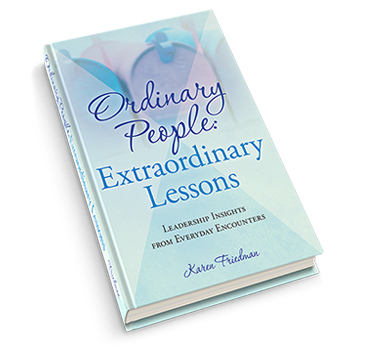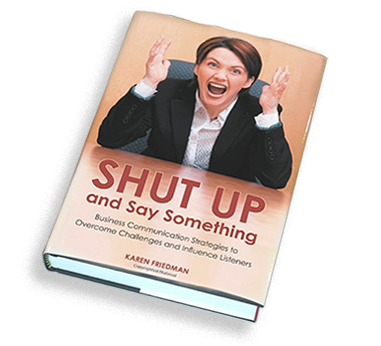The group of seasoned medical professionals were sent our way to improve their presentation and communication skills. We are fortunate to work with brilliant experts across many industries but being the smartest person in the room doesn’t always translate to good communication skills.
Most of the time, people who come to us want help. Like the skills they’ve worked so hard to develop in their chosen profession, they want to be the best they can be at everything they do. However, every now and then, someone in a group says they want help, but when asked, they can’t think of any areas of leadership communication skills they really need to work on. It’s obvious to a seasoned coach that they are likely only attending because a higher-up told them to.
At least that was my perception of Melissa. She said she’s had communication coaching before and couldn’t think of anything she needed to work on but maybe she’d pick up a few tips. As Melissa began delivering a scientific presentation she often gives to other medical experts, it was exceedingly difficult to follow her. She was speaking so fast that listeners, including me, were having a hard time processing what she was saying.
I am not a big fan of telling people to slow down. While they understand what that means, they typically slow down for thirty seconds and then speed back up. So, I told Melissa to pause. Like a book or this article that offers punctuation, speakers can punctuate with their voice.
Melissa disagreed. She says she knows she talks fast but told the group she has a lot to say and is never given enough time to say it. She said she needs to respect that her audience is comprised of extremely busy people, so she is being respectful of their time by cramming seven minutes of material into four minutes.
Whether presenting, speaking at a meeting or even having one-on-one conversations, if you are trying to get a message across and make sense of information for others, speaking too quickly can muddle your message because people tend to tune out. You might also come across as someone who is simply plowing through information to get it over with. Though Melissa wanted to respect her audience’s time, she inadvertently was doing the opposite. If her audience found her difficult to listen to, they might feel as if she was wasting their time. Additionally, people who speak too quickly are often perceived as nervous or anxious. That distracts attention and can make you look as if you are not in full command of your material.
Even though you are the only one speaking when presenting, it’s important to approach a presentation as a dialogue, not a monologue. When we pause and ask rhetorical questions like we do in conversations, it’s easier for listeners to process what is being said and the speaker will exhibit greater command and presence.
Melissa was skeptical. So, I suggested that she try presenting again, this time, applying my suggestions even if it felt awkward to her. Reluctantly, she said okay. The difference was significant. Her colleagues, who are well versed in her subject matter told her that they had been having a hard time understanding her too. However, when she presented again applying pauses, they felt she came across as more polished, confident and they said they had a better understanding of the data she was explaining.
Speaking too quickly is only part of the issue. Melissa and many others we work with simply go on too long whether they pause or not. In an age of shrinking attention spans, less really is more.
Here are my top four tips to slow yourself down and deliver material in a more polished confident manner.
PAUSE. PAUSE. PAUSE
When people who speak too fast are told to pause, they often feel uncomfortable with the silence. They tend to use fillers like and, just, so, you know, um and uh to manage that silence. As a former television news anchor, before sending a script to the teleprompter, I would put dark slash marks after words where I wanted to pause to slow it down or emphasize a key point.
TRIM THE FAT
Time yourself. If it takes you three minutes to say something, try saying it in two, then in one. Instead of telling audiences everything you know, think about what they really need to know. What would you care about if you were them? Cutting out the excess helps make messages crisper, clearer and easier to comprehend for those listening to you.
SPEAK SENTENCES DIFFERENTLY
To practice, pick a sentence to read from a printed publication. Each time you read it, pause in a different place. You will notice how the meaning of what you’re saying will change. As an example, ‘we have the ability to increase profits by 50% in Q4.” Then say ‘we have the ability to increase profits (pause) by 50% (pause) in Q4.
SIMPLIFY THE COMPLICATED
Sometimes what we are saying is contains a lot of information and can be difficult for people to process if you are speaking too quickly. You can try breaking the sentence into two sentences to make it easier to comprehend. You can also think of explaining things in numbers such as ‘there are three key pieces of information I want you to consider.’ Then explain them one at a time.
Remember, public speaking is different than having a conversation. When speaking in a meeting, on a panel, in a boardroom or anywhere there is an audience, this is considered public speaking. When speaking publicly, it’s important to adjust and slow your pace. That’s why the techniques above are so important. When you speak too quickly, your listeners may hear the words you said, but that doesn’t mean they heard your message.








Leave a Reply
You must be logged in to post a comment.